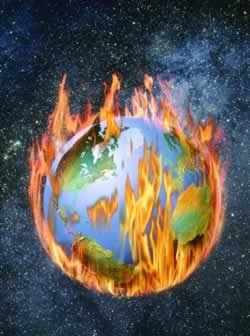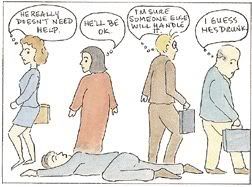
It was a hot July day in 1944. The Barnum and Bailey circus was in Hartford, Connecticut. Filling the world's biggest tent were over 8,000 people, mostly children with their mothers, watching the Flying Wallendas step out on the high wire.
Then the southwest tent wall caught fire.
Psychologists who study people's reactions to disasters talk about the difficulty of breaking out of normal behavior patterns. Although we all know we're supposed to run from a fire, in an actual emergency we simply don't believe this is real. We don't want to embarrass ourselves by running screaming from a hoax or misperception. Dulled from a lifetime of safety, we glance out of the corners of our eyes to see how others are reacting. Of course, they're struggling to look calm too.
John Darley of Princeton University became famous for his series of experiments into the 'bystander effect.' He never told the subject of his experiment that the experiment had already started, but simply left the person in a room with instructions to fill out forms for the “upcoming†study. After a few moments, he started pumping dark smoke into the room through the air conditioning vent. The smoke got thicker and thicker, while he timed how long it took the subject to leave the room for help.
The only variable was if there were other people in the room. These people were stooges who Darley paid to act as if nothing was going on. If the subject asked about the smoke, these stooges shrugged, as though it wasn't anything special.
We all know the polar ice is melting, that the world's temperature is rising. We can feel in our guts the weather is changing, becoming unbalanced.
If the subject was alone, there was a 70% chance s/he would get help within four minutes.
The coral reefs are dying, winter is getting shorter, rain and drought are becoming more extreme.
If the subject was with stooges, however, there was only a 12% chance s/he would get help. Instead subject after subject stayed there for the whole experiment, filling out forms until the smoke was too thick to see the paper anymore, until s/he couldn't see a hand held in front of the face. The results of this experiment have been confirmed and reconfirmed by different experimenters over the past three decades.
The arctic permafrost is made up of millions of tons of carbon in the form of frozen plant matter. It's never had a chance to decompose into the atmosphere because it's always been frozen. It's starting to defrost now. This carbon could dramatically speed up the change in the climate.
The top of the circus tent was waterproofed with melted wax thinned with gasoline. One couple was talking with a pregnant woman and her children about what to do. She said they should stay, the fire would soon be put out.
All of us read about global warming and wonder what to do. Looking around, we see our neighbors getting in their cars to drive to work, their expressions neutral. At work, no one brings the subject up.
William Moomaw, Director of Tufts University Institute of the Environment, said, "We see global warming as too monumental, our actions won't make a difference." Even if we have the internal strength to keep conscious of what we believe to be a huge problem, we think we are all alone in our feeling. Individually, we feel too small and self-conscious to make a difference.
Lauren Slater --celebrated psychologist and author of the book, Great Psychological Experiments of the 20th Century-- is an expert on Darley’s bystander effect. “The feeling of safety in a crowd isn’t accurate,†said Slater. “Research shows the more people around, the more you feel beholden to social etiquette. If there’s the slightest ambiguity about the danger inherent in the situation, you won’t act.â€

The world's population is over six billion, creating the ultimate bystander effect.
When the flames reached the circus roof, they streaked up a waxy seam. The fire moved so fast, people stood up entranced, rather than run, a reaction psychologists call "collective disbelief." As soon as the fire reached the center pole it split in three directions, following the fuel along the seams. Everyone who saw it had a different metaphor: cellophane on fire, tissue paper, a fuse. It moved faster than the fastest man.
Darley has found in emergency situations, once one person starts to help, others are much more likely to act. In the case of the circus fire, a few people finally started to run, breaking the frozen horror of the rest.
Moomaw found the most effective exercise he ever had his Tufts environmental policy students do was to calculate the net result of their life style choices on the environment: the resources they consumed, the tons of carbon each of them individually emitted. Twenty years after taking his course, he's had students approach him to say this resource exercise was the most transformative experience of their college career.
Slater explained this lasting effect. “Moomaw is putting them through the first three steps of the five-stage model of stopping the bystander effect. Noticing the problem and taking responsibility for it are the first two steps. Once they imagine their own impact multiplied by six billion other people, they reach the third step of recognizing it as an emergency.†The final two steps of this process are deciding on an action and doing it.
Slater continued, “What’s interesting with Moomaw’s students is they managed to sustain the effect of the exercise all these years later. Perhaps this is because of cueing. For the rest of their lives, these students are being cued to remember the experience every time they eat or do their laundry [every time they use resources]. To give a different example, with nuclear weaponry, there aren’t constant social cues. We don’t see streets lined with silos so we tend to forget about them.â€
Slater added, “Environmental activists are people who are able to pick up cues to resource-depletion in their normal lives.â€
In the 1944 circus fire, the stampede for safety started too late. The temperature in the tent quickly rose, becoming unbearable, people screaming. Burning pieces of the wax-encrusted roof began to fall. Over 160 people (mostly women and children) were burned or crushed by the panicked crowds. The rest managed to flee out the exits to safety.
From a burning world, there is no exit. What we desperately need now are more activists, a lot of them, ones who’ll jump out of their seats, scream noisily at the top of their lungs and lead the rush to safety.
1 comment:
Yes exactly, in some moments I can phrase that I approve of with you, but you may be inasmuch as other options.
to the article there is even now a definitely as you did in the fall issue of this demand www.google.com/ie?as_q=collectorz.com comic collector pro 4.0.2 ?
I noticed the catch-phrase you have in the offing not used. Or you use the dark methods of helping of the resource. I take a week and do necheg
Post a Comment